Volume 1, Number 7 - Spring 1963
LAKE TANEYCOMO and POWERSITE DAM FIFTIETH ANNIVERSARY
Lake Taneycomo shortly after completion of Powersite Dam
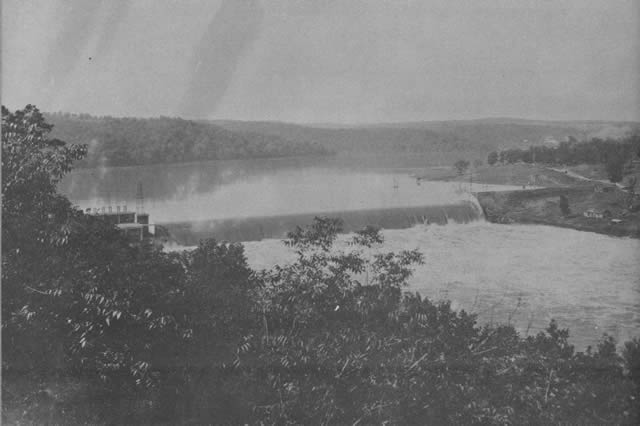
Photo courtesy Empire District Etectric Co.
"There are some dams that are longer and some that are higher, but to the best of our knowledge this is the biggest dam in this country that is used exclusively for the generation of electricity for commercial purposes. Some idea of the size of the structure may be obtained from the figures here, but to really understand just how big this thing is it will be necessary to visit the plant and see for yourself. The entire length of the structure is something over twelve hundred feet, of which the power house takes up 210 feet, the spillway of the dam 576 feet, and the corewall at the north side of the river 440 feet."
-- F. F. Baily, July 10, 1913.
[2]
"Along in the fall of 1911, the Ambursen people began to get their men and machinery on the ground and prepare to put the plans into execution."
-- F. F. Baily
"A. J. Zwart was the first one who came down or the promoters for Powersite Dam-Morrison and McCall, who had offices in St. Louis, and had a franchise from the government to build the dam. After the first survey, they sent for my father, M. L. Holman of St. Louis, who was consulting engineer. He advised them to go down the river about five miles. I had come down here first in 1911, and had been living at the first dam site. I picked out the location where the dam is now, about two miles above old Forsyth. It was known as the Sam Wheeler property. Jim Root, J. C. and J. H. Parrish also owned farms there."-- C. H. Holman
"The dam is being constructed by the Ambursen Hydraulic Construction Co., of Boston, Mass., who are agents for the White River Construction Co., and is to be of the celebrated Ambursen type which is rapidly becoming the best known and most popular hydraulic structure known to the engineering profession."
Taney County Republican
Dec. 7, 1911
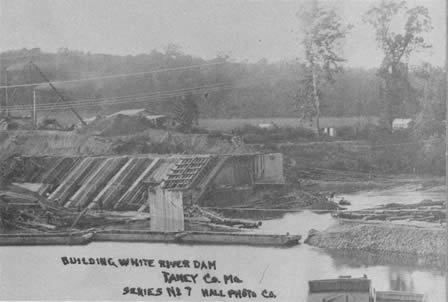
Photos courtesy Juanita Franklin and Dr. L. S. Shumate
[3]
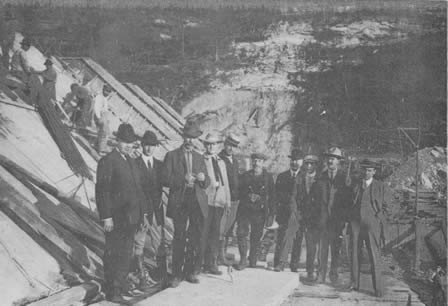
Photo courtesy Empire District Electric Co.
Second from left: T. C. Kennedy, secretary of the White River Construction
Co, and purchasing agent; 4th from left: Russell T. Bailey, resident engineer;
5th from left: W. E. Maxon, superintendent of construction for Ambursen Hydraulic
Construction Co.
Taney Co. Republican, December 7, 1911
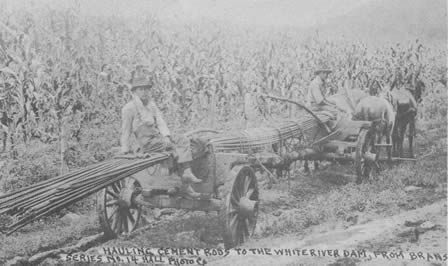 Photo courtesy Juanita Franklin and Dr. L. S. Shumate
Photo courtesy Juanita Franklin and Dr. L. S. Shumate
"Fifty or sixty wagons and teams were used by the Ozark Power Company to haul supplies from the railroad at Branson to the dam. When the river was up, they had to ferry the river twice, at Compton's Ferry below Roark, and at Chapman's Ferry about two miles above the dam site. We had three wagons come down every day from the Branson railroad to supply the commissary which I took over at Camp Ozark in 1912."
-- B. A. Parnell, Sr.
[4]
"THERE IS GOING TO BE PLENTY OF WORK AT THE DAM FOR THOSE
WHO WANT TO WORK"
Taney County Republican, Nov. 23,1911
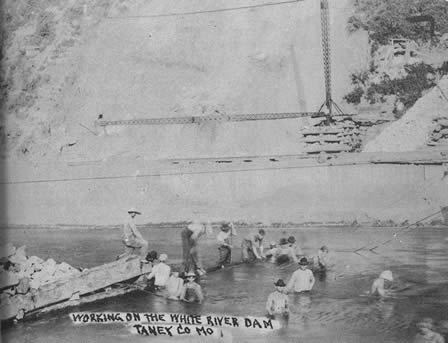 "The beginning of actual construction of the dam on White
River above Forsyth marks a new period of prosperity in the his tory of Taney
County. It is by far the largest single piece of structural work ever attempted
in this section, and with the in creased number of laborers and skilled workmen
brought into the country a large benefit will surely be felt by the county as
a whole. (It) will represent an expenditure of about $500,000."
"The beginning of actual construction of the dam on White
River above Forsyth marks a new period of prosperity in the his tory of Taney
County. It is by far the largest single piece of structural work ever attempted
in this section, and with the in creased number of laborers and skilled workmen
brought into the country a large benefit will surely be felt by the county as
a whole. (It) will represent an expenditure of about $500,000."
(Dec. 7, 1911)
"Four of the big barges had been landed that morning from Branson, each carrying a big load of the tools and machinery to be used in the work. These barges made the trip from Branson to the landing, something like 16 miles . .. in three hours and ten minutes."
(Dec. 28, 1911)
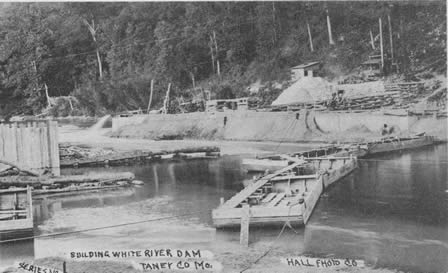 "Each of the barges is about ten by thirty feet and are
built of heavy two and one half inch planks ... When loaded the boats will draw
something like eighteen Inches to two feet of water. It is estimated that it
will require about seven hundred and fifty carloads of cement in the construction
. . no small thing to transport from the railroad."
"Each of the barges is about ten by thirty feet and are
built of heavy two and one half inch planks ... When loaded the boats will draw
something like eighteen Inches to two feet of water. It is estimated that it
will require about seven hundred and fifty carloads of cement in the construction
. . no small thing to transport from the railroad."
(Dec. 28, 1911)
Photos courtesy Juanita Franklin and Dr. L. S. Shumate
[5]
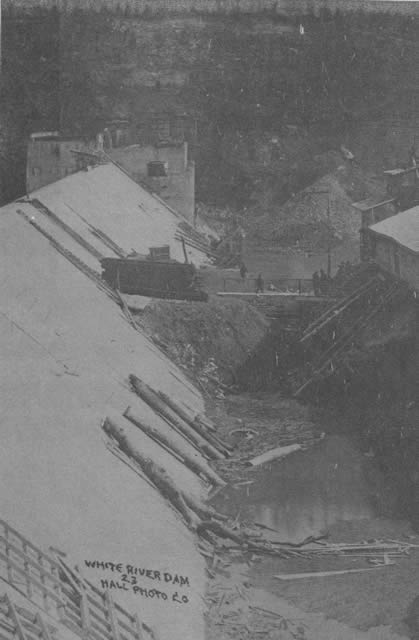 |
THE AMBURSEN HOLLOW DAM "In the solid dam a section must be used whose weight per foot is about three times the greatest water pressure. The Ambursen hollow dam is built with an inclined upstream face so that the water tends to equalize this horizontal pressure. (It) consists of vertical concrete steel walls or buttresses, triangular in sec tion placed from fifteen to twenty feet apart parallel with the current of the river, and with the vertical face down strea, and the inclined face sloping up stream. On this inclined slope are placed slabs of reinforced concrete varying in thickness. being thicker as the base of the dam is approached." R. T. Bailey, C. E., July 10, 1913 Photos courtesy Juanita Franklin and Dr. L. S. Shumate |
|
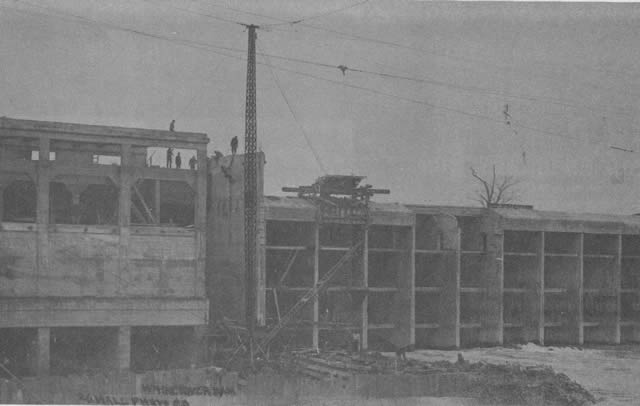 |
||
[6]
"An opening was left about the middle, here the concrete mixers were located, so that material could be carried both ways from there." -- F. F. Baily
"The pay roll for day laborers, not counting salaried men, ran about $1,500 a day for nearly two years." -- F. F. Baily |
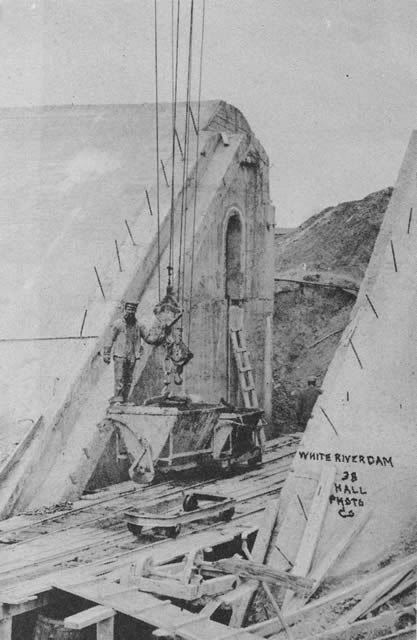 |
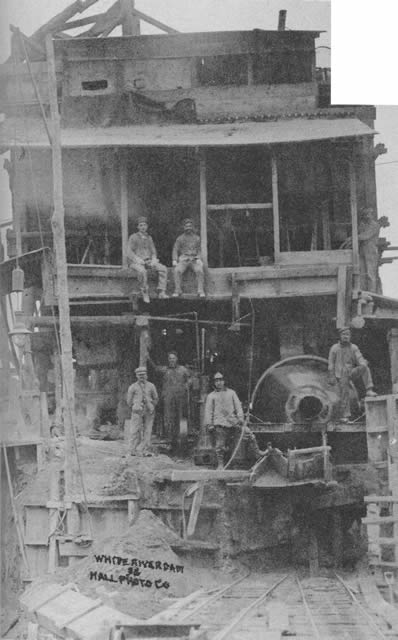 |
"Many of the workers were local men, but since there weren't enough of them, the company imported laborers. Some were natives of Italy and Bulgaria." -- B. A. Parnell, Sr.
"The dam did furnish a liveable wage; before in Taney County, there was little employment for most of the people. Just a few years before the Dam was started, a man worked hard and long hours for his room and board, or he boarded at home and received 50c a day for his labor." -- Mrs. O. A. Blankinship |
[7]
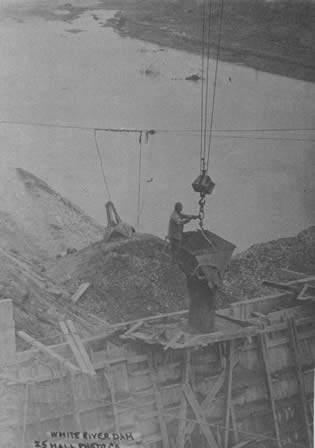 |
"Taking into consideration the large number of men employed and the hazardous employment that a great many of them were engaged in, it seems remarkable that they escaped with so few serious accidents, and only one fatality." (The one fatality was Carl Kressig who drowned when thrown from a barge making a landing at the dam.) -- F. F. Baily |
|
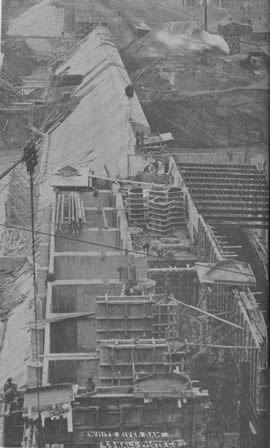 |
C. H. Holman was in charge of the men working on the upper river survey. In the picture below are: Goff, Hibbard, Thomas, Breitenstein, Breedon, _________, Sargent, Dooms, Hall, Sargent, Holman, Lewis, and Whitlock. |
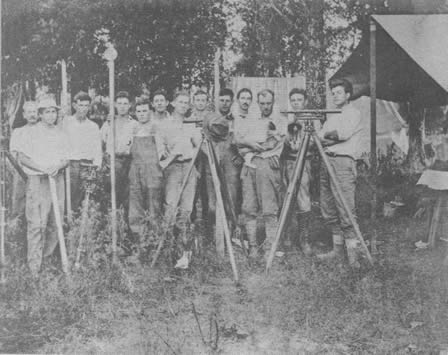 |
[8]
"Old timers here know what the river can do when she
gets her back up"
Taney County Republican
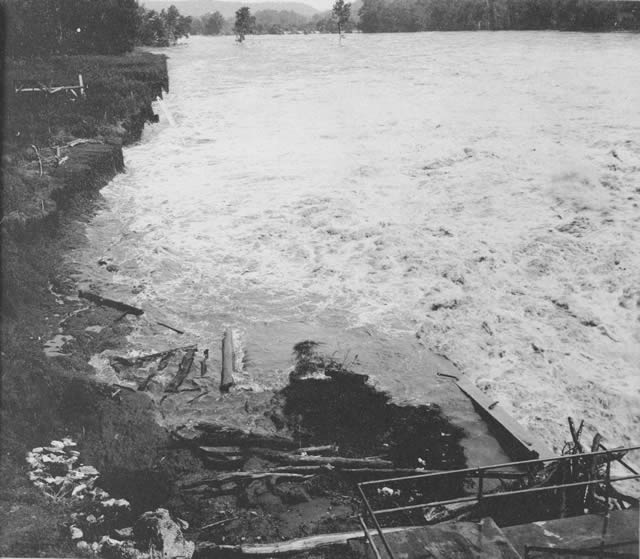
Flood waters roar downstream toward Forsyth
"When the lake was filled, the ground below the spillway was rapidly eaten away by the water which poured over in a stream almost six hundred feet wide and almost six feet deep."
-- F. F. Baily
[9]
"A wide sheet of yellow velvet suspended from the top of the dam."
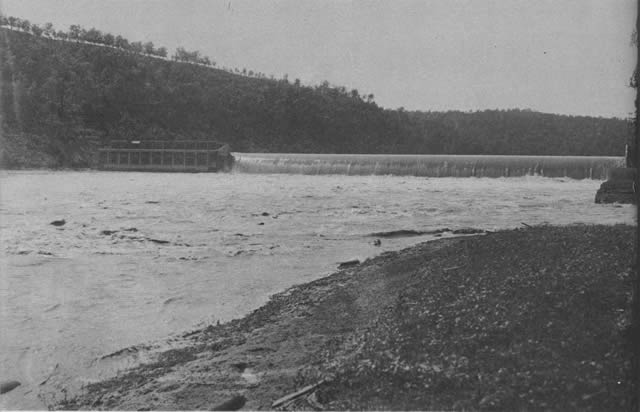
Photo courtesy Empire District Electric Co.
"The lake made by this dam is something over twenty miles in length and from a quarter to three quarters of a mile wide, and affords many beautiful sites for club houses, camps, and permanent homes.."
-- F. F. Baily, July 10, 1913
"As the dam was being completed, Maxon asked for reports on the river. I had observers at different points upstream, and just when they made the closure, the observers began to telephone in that there had been a cloudburst upriver. We had expected the lake to take two to three weeks to fill since there had been little rain, but it filled in less than two days."-- C. H. Holman
[10]
This volume: Next Article | Table of Contents | Other Issues
Other Volumes | Keyword Search | White River Valley Quarterly Home | Local History Home
Copyright © White River Valley Historical Quarterly

